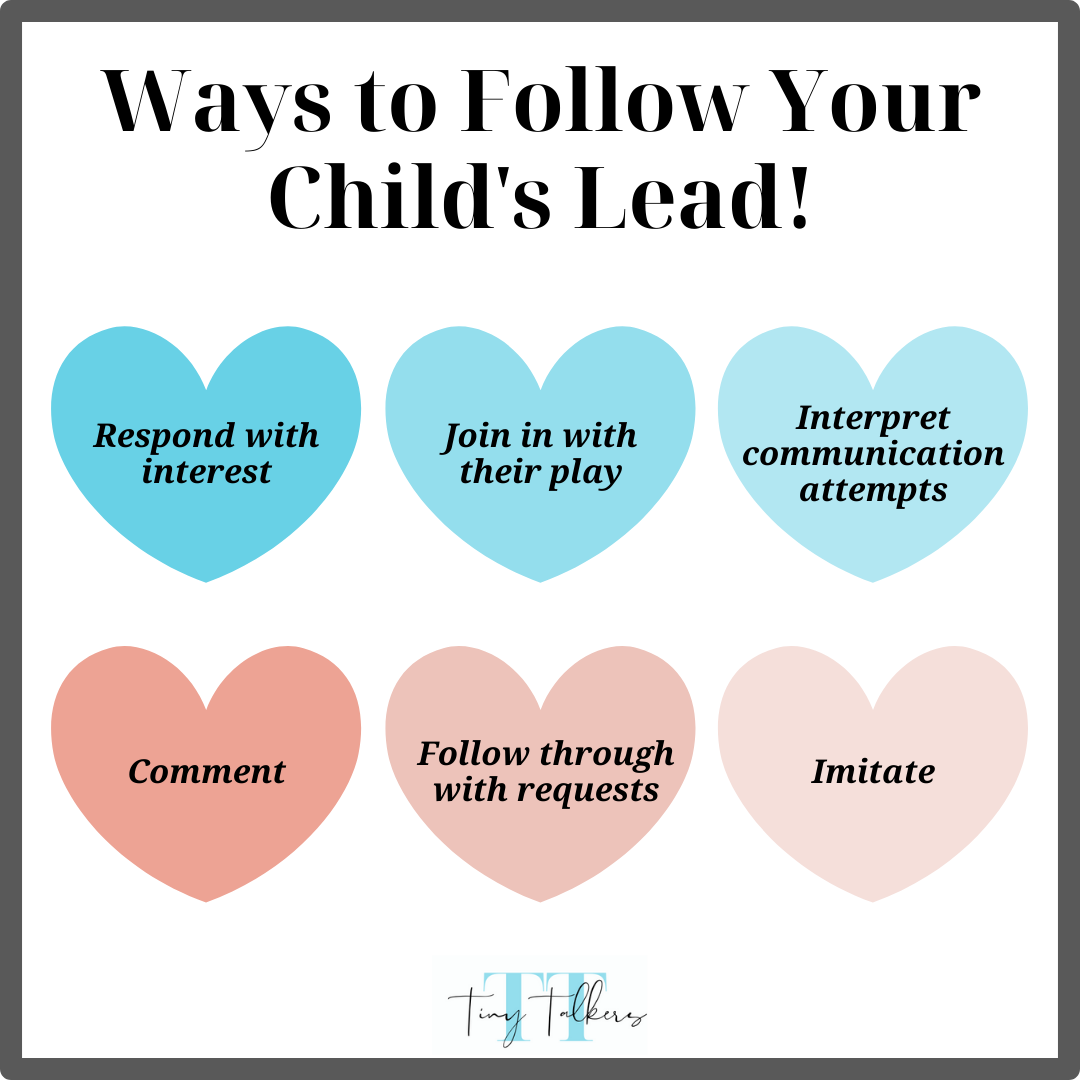Follow your child’s lead! But, what does that even mean?!
Parents often ask how they can encourage communication, including babbling, gestures, vocalizing, and first words! One of our biggest suggestions is to follow their lead. Why? It’s a very low-pressure way to interact with your child! For many kids, reducing pressure is KEY. Less pressure allows your child to communicate when they are ready!
Ways to Follow Your Child’s Lead
When we talk about following their lead, it sounds simple enough, but there are many different ways you can use this strategy so that you are encouraging communication! We consider where a child is developmentally, as well as, the context of communication!
Something to consider is HOW your child communicates because this will guide how you follow their lead. If your child is not verbally communicating, they may use eye contact, gestures, or facial expressions. If this is how your child communicates, you’ll want to be sure to respond when they do these things. If your child also tends to coo, babble, vocalize, or attempt words, then you‘ll want to reinforce these interactions as well!
Generally speaking though, when we talk about 𝗳𝗼𝗹𝗹𝗼𝘄𝗶𝗻𝗴 𝘆𝗼𝘂𝗿 𝗰𝗵𝗶𝗹𝗱’𝘀 𝗹𝗲𝗮𝗱, we mean taking the back seat and letting them direct the play or interaction! By doing this, you are encouraging them to communicate with you in a low-pressure way. 🙌
𝗛𝗲𝗿𝗲 𝗮𝗿𝗲 𝘀𝗼𝗺𝗲 𝘄𝗮𝘆𝘀 𝘆𝗼𝘂 𝗰𝗮𝗻 𝗳𝗼𝗹𝗹𝗼𝘄 𝘆𝗼𝘂𝗿 𝗰𝗵𝗶𝗹𝗱’𝘀 𝗹𝗲𝗮𝗱:
Respond immediately to what your child says or does with interest! Communication is reciprocal! That means it is not a one-sided interaction. All communication happens for a reason, and to help your child learn that their communication serves a purpose, we want to make sure we are responding to them. This does not mean responding to only verbal attempts; it means responding to ALL communication attempts and doing so with interest! When we show interest in our little one’s communication, it reinforces the interaction and encourages them to do MORE. You can respond with interest through your facial expression, eye contact, verbal response, and gestures. It’s important that you respond immediately after you notice your child attempting to communicate so that they can see the effect of their communication.
Join in with their play! You can do this by playing like they are playing, adding fun sounds/words to their play, or engaging in pretend play. When we follow our child’s lead during play, the key is not to direct the play. Avoid telling your child how to play. Instead, pay attention to how your child is playing and follow along! This encourages them to initiate more interactions with you. If it seems like your child is unsure of what to do, try grabbing your own toy and start playing! Your child may take over the play so you can follow along.
Imitate your child’s actions, words, and sounds. We love imitation because it encourages communication regardless of your child’s age! For example, you can imitate an infant’s coos, babbles, and facial expressions or you can imitate a toddler’s actions, gestures, and sounds! Imitation can be really effective with getting interactions going, and it lets your child know that you acknowledge their communication!
Interpret what they are trying to say and respond with words or a description to match. We get that you won’t always know what your child is trying to tell you, and those moments can be frustrating for your child! But, try your best to follow your child’s lead by looking at the context of the communication and responding. A response showing interest is always better than no response.
Comment about what they are looking at, saying, or doing. Sometimes little ones don’t want anyone playing with them, and that’s okay. You can still comment about what they are doing or even grab your own toy and talk about what you are doing. The goal is to create an environment that lets your child know you are interested in interacting with them without directing them to do so! Commenting also avoids asking your child to talk. Instead of asking your child what they see (more pressure), try commenting about their looking at (less pressure)!
Follow through with actions or words that indicate a request. A big reason that your little one communicates is to make a request! Requests can come in many forms - eye gaze, pointing, taking your hand, vocalizing, or words! When your child initiates a request, be sure to respond! For example, if they look at a bottle and then at you, respond, “Bottle?” This encourages them to initiate more requests!
🗝 The key to following your child’s lead is to be engaged and show interest! By doing this, you are encouraging your child to respond to you!
Have you tried this with your child?
Open-ended toys
We love open-ended toys (i.e. toys that don’t play by themselves 😉) because they offer endless opportunities for play and can span the ages!
Here are some of our favorites that your little one can play with, while you follow their lead and encourage communication!







